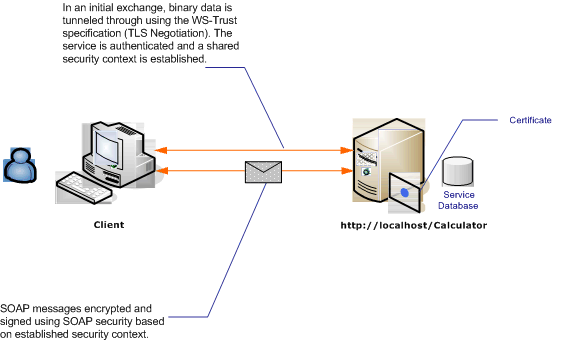Seguridad de mensajes con clientes anónimos
En el escenario siguiente se muestra un cliente y un servicio que protege la seguridad de mensajes de Windows Communication Foundation (WCF). Un objetivo del diseño es usar la seguridad del mensaje en lugar de la seguridad de transporte, para que en el futuro pueda admitir un modelo basado en notificaciones más completo. Para obtener más información sobre el uso de notificaciones enriquecidas para la autorización, vea Administración de notificaciones y autorización con el modelo de identidad.
Para obtener una aplicación de ejemplo, vea Seguridad de mensaje anónima.

| Característica | Descripción |
|---|---|
| Modo de seguridad | Message |
| Interoperabilidad | Solo WCF |
| Autenticación (servidor) | La negociación inicial requiere la autenticación del servidor, pero no la autenticación del cliente |
| Autenticación (cliente) | None |
| Integridad | Sí, mediante el contexto de seguridad compartido |
| Confidencialidad | Sí, mediante el contexto de seguridad compartido |
| Transporte | HTTP |
Servicio
El código y la configuración siguientes están diseñados para ejecutarse de forma independiente. Realice una de las siguientes acciones:
Cree un servicio independiente mediante el código sin configuración.
Cree un servicio mediante la configuración proporcionada, pero sin definir ningún punto de conexión.
Código
El código siguiente muestra cómo crear un extremo de servicio que utiliza la seguridad del mensaje.
// Create the binding.
WSHttpBinding binding = new WSHttpBinding();
binding.Security.Mode = SecurityMode.Message;
binding.Security.Message.ClientCredentialType =
MessageCredentialType.None;
// Create the URI for the endpoint.
Uri httpUri = new Uri("http://localhost/Calculator");
// Create the service host and add an endpoint.
ServiceHost myServiceHost =
new ServiceHost(typeof(ServiceModel.Calculator), httpUri);
myServiceHost.AddServiceEndpoint(
typeof(ServiceModel.ICalculator), binding, "");
// Specify a certificate to authenticate the service.
myServiceHost.Credentials.ServiceCertificate.SetCertificate(
StoreLocation.LocalMachine,
StoreName.My,
X509FindType.FindByThumbprint,
"00000000000000000000000000000000");
// Open the service.
myServiceHost.Open();
Console.WriteLine("Listening...");
Console.ReadLine();
// Close the service.
myServiceHost.Close();
' Create the binding.
Dim binding As New WSHttpBinding()
binding.Security.Mode = SecurityMode.Message
binding.Security.Message.ClientCredentialType = _
MessageCredentialType.None
' Create the URI for the endpoint.
Dim httpUri As New Uri("http://localhost/Calculator")
' Create the service host and add an endpoint.
Dim myServiceHost As New ServiceHost(GetType(ServiceModel.Calculator), httpUri)
myServiceHost.AddServiceEndpoint(GetType(ServiceModel.ICalculator), binding, "")
' Specify a certificate to authenticate the service.
myServiceHost.Credentials.ServiceCertificate.SetCertificate(StoreLocation.LocalMachine, _
StoreName.My, X509FindType.FindByThumbprint, "00000000000000000000000000000000")
' Open the service.
myServiceHost.Open()
Console.WriteLine("Listening...")
Console.ReadLine()
' Close the service.
myServiceHost.Close()
Configuración
En lugar del código, se puede utilizar la siguiente configuración. El elemento de comportamiento del servicio se utiliza para especificar un certificado utilizado para autenticar el servicio al cliente. El elemento de servicio debe especificar el comportamiento mediante el atributo behaviorConfiguration. El elemento de enlace especifica que el tipo de credencial de cliente es None, de modo que permite a los clientes anónimos utilizar el servicio.
<?xml version="1.0" encoding="utf-8"?>
<configuration>
<system.serviceModel>
<behaviors>
<serviceBehaviors>
<behavior name="ServiceCredentialsBehavior">
<serviceCredentials>
<serviceCertificate findValue="contoso.com"
storeLocation="LocalMachine"
storeName="My" />
</serviceCredentials>
</behavior>
</serviceBehaviors>
</behaviors>
<services>
<service behaviorConfiguration="ServiceCredentialsBehavior"
name="ServiceModel.Calculator">
<endpoint address="http://localhost/Calculator"
binding="wsHttpBinding"
bindingConfiguration="WSHttpBinding_ICalculator"
name="CalculatorService"
contract="ServiceModel.ICalculator" />
</service>
</services>
<bindings>
<wsHttpBinding>
<binding name="WSHttpBinding_ICalculator" >
<security mode="Message">
<message clientCredentialType="None" />
</security>
</binding>
</wsHttpBinding>
</bindings>
<client />
</system.serviceModel>
</configuration>
Remoto
El código y la configuración siguientes están diseñados para ejecutarse de forma independiente. Realice una de las siguientes acciones:
Cree un cliente independiente mediante el código (y el código de cliente).
Cree un cliente que no defina direcciones de punto de conexión. En su lugar, utilice el constructor de cliente que adopta el nombre de configuración como un argumento. Por ejemplo:
CalculatorClient cc = new CalculatorClient("EndpointConfigurationName");Dim cc As New CalculatorClient("EndpointConfigurationName")
Código
En el ejemplo de código siguiente se crea una instancia de cliente. El enlace utiliza seguridad en modo de mensaje y el tipo de credencial de cliente está establecido como ninguno.
// Create the binding.
WSHttpBinding myBinding = new WSHttpBinding();
myBinding.Security.Mode = SecurityMode.Message;
myBinding.Security.Message.ClientCredentialType =
MessageCredentialType.None;
// Create the endpoint address.
EndpointAddress ea = new
EndpointAddress("http://localhost/Calculator");
// Create the client.
CalculatorClient cc =
new CalculatorClient(myBinding, ea);
// Begin using the client.
try
{
cc.Open();
Console.WriteLine(cc.Add(200, 1111));
Console.ReadLine();
// Close the client.
cc.Close();
}
' Create the binding.
Dim myBinding As New WSHttpBinding()
myBinding.Security.Mode = SecurityMode.Message
myBinding.Security.Message.ClientCredentialType = MessageCredentialType.None
' Create the endpoint address.
Dim ea As New EndpointAddress("http://localhost/Calculator")
' Create the client.
Dim cc As New CalculatorClient(myBinding, ea)
' Begin using the client.
Try
cc.Open()
Console.WriteLine(cc.Add(100, 11))
Console.ReadLine()
' Close the client.
cc.Close()
Catch tex As TimeoutException
Console.WriteLine(tex.Message)
cc.Abort()
Catch cex As CommunicationException
Console.WriteLine(cex.Message)
cc.Abort()
Finally
Console.WriteLine("Closed the client")
Console.ReadLine()
End Try
Configuración
El siguiente código configura el cliente.
<?xml version="1.0" encoding="utf-8"?>
<configuration>
<system.serviceModel>
<bindings>
<wsHttpBinding>
<binding name="WSHttpBinding_ICalculator" >
<security mode="Message">
<message clientCredentialType="None" />
</security>
</binding>
</wsHttpBinding>
</bindings>
<client>
<endpoint address="http://machineName/Calculator"
binding="wsHttpBinding"
bindingConfiguration="WSHttpBinding_ICalculator"
contract="ICalculator"
name="WSHttpBinding_ICalculator">
<identity>
<dns value="contoso.com" />
</identity>
</endpoint>
</client>
</system.serviceModel>
</configuration>